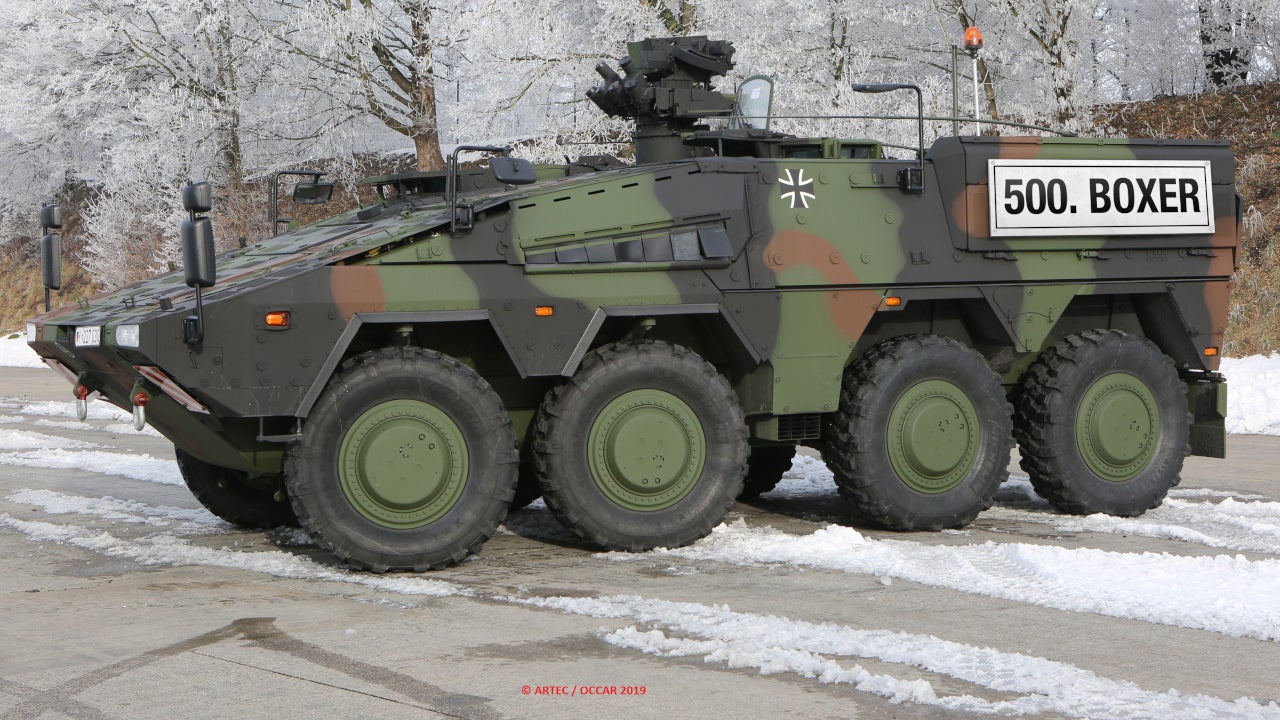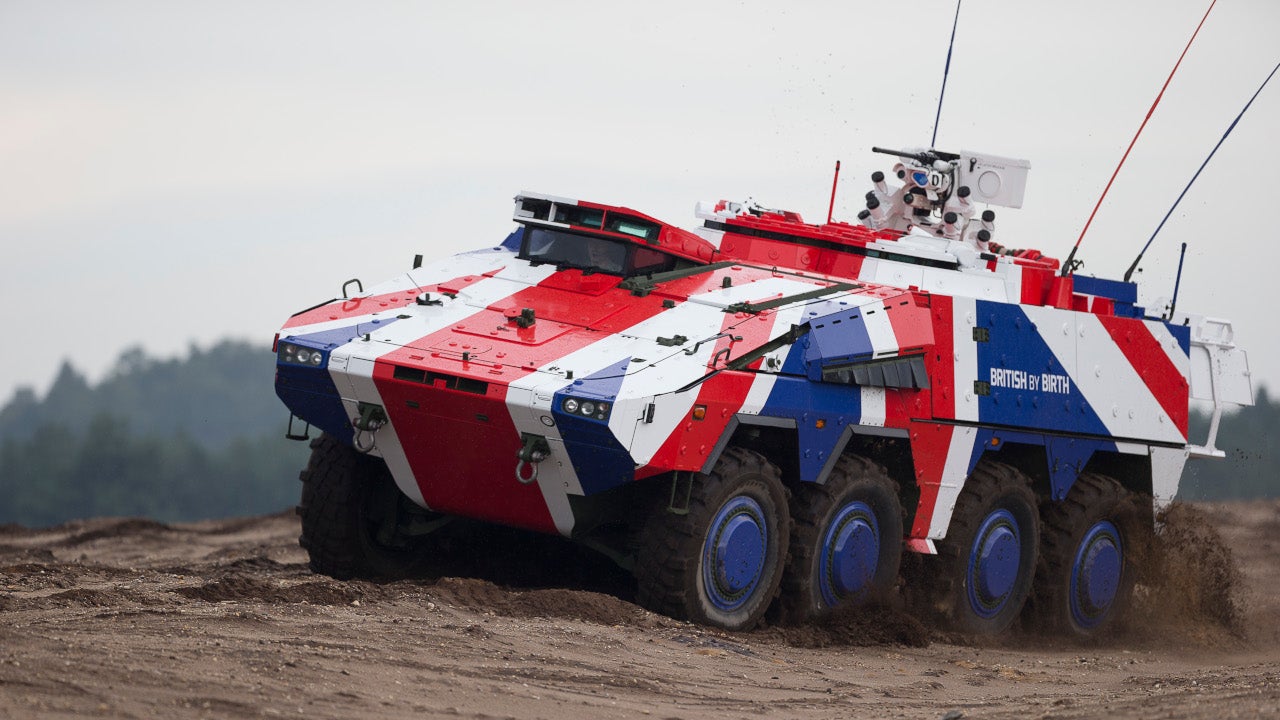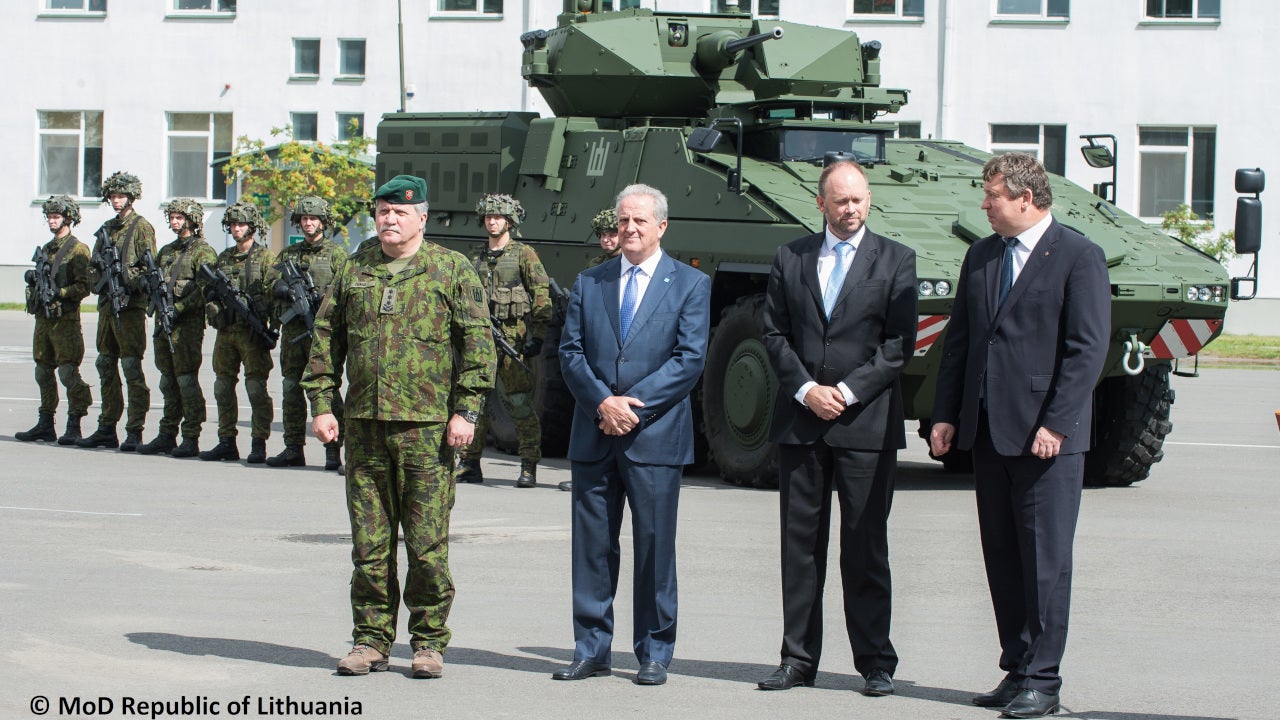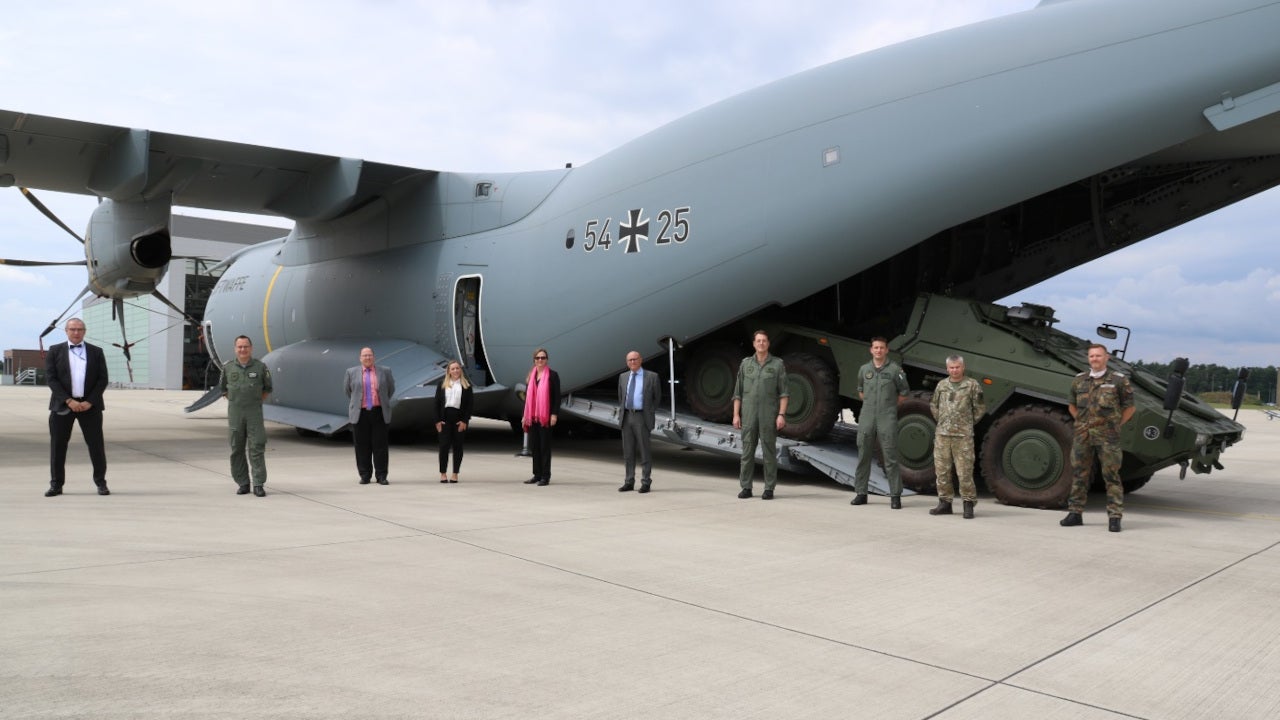Boxer is an 8×8 multirole armoured vehicle (MRAV) managed by the European Armaments Agency, Organisation for Joint Armament Cooperation (OCCAR).
The MRAV has the capability to operate in both high-intensity conflict as well as in relief and humanitarian operations.
The governments of the UK and Germany signed a contract in November 1999 for the collaborative development and initial production of a family of next-generation armoured utility vehicles.
The programme was known as the Multi-Role Armoured Vehicle (MRAV) in the UK, and as the Gepanzertes Transport-Kraftfahrzeug (GTK) in Germany. The British Army’s vehicle allows for the different configurations such as command vehicle, specialist carrier, armoured personnel carrier, and field ambulance, which can accommodate six seated or three stretcher casualties.
In February 2001, the Netherlands signed a memorandum of understanding to join the programme. The Dutch programme is called the Pantser Wiel Voertuig (PWV). In December 2002, it was announced that the vehicle would be called the Boxer.
Industrial group ARTEC consisting of Krauss-Maffei Wegmann (KMW) and Rheinmetall Landsysteme from Germany, and Stork of the Netherlands is the prime contractor for the programme. Stork PWV became part of Rheinmetall in March 2008.
In July 2003, the UK Ministry of Defence (MoD) announced it would withdraw from the programme to pursue a new national programme, the future rapid effect system (FRES). The MoD required a lighter more easily deployable vehicle.
The MoD announced its plans to re-join the Boxer programme in April 2018 for its Mechanised Infantry Vehicle (MIV) programme. The Boxer programme reached a milestone by delivering the 500th vehicle in February 2019.
The Boxer vehicle was unveiled with Leguan bridging module in August 2020.
Boxer MRAV prototypes and development
The UK, Germany and Netherlands were each to receive four prototypes and a first batch of 200 vehicles. The first prototype, in German APC configuration, was rolled-out to representatives of OCCAR and participating nations in December 2002 and the first Dutch prototype, a command post version, was completed in October 2003.
A contract was signed in November 2004, between OCCAR (for Germany and the Netherlands) and ARTEC, for the bilateral continuation of the development programme. A total of 12 prototype vehicles have been built and are undergoing industry trials.
ARTEC presented a bid to OCCAR for the first production batch of 400 vehicles in November 2005, which was rejected on grounds of cost.
The Dutch announced in February 2006 that it would launch a new competition for the requirement. However, in May 2006, ARTEC submitted a revised bid for the Boxer.
In July 2007, Boxer was one of three vehicles that took part in trials (the ‘Trials of Truth’) for the utility variant of the UK Army’s FRES. The General Dynamics Piranha V was provisionally selected for the requirement in May 2008, although in December 2008 the preferred bidder status was withdrawn.
In July 2020, the Lithuanian Boxer programme completed successful trails for the Boxer Drive Modules in the A400M.
Orders and deliveries
In June 2006, the Dutch Parliament approved procurement of 200 Boxer vehicles (58 ambulance, 55 command post, 41 engineer, 27 cargo and 19 cargo / command versions). In December 2006, Germany approved the procurement of 272 vehicles (135 armoured personnel carrier, 65 command post and 72 ambulance variants). A production contract was signed with ARTEC on 19 December 2006.
Boxer successfully completed user trials with the German Army in January 2008. In September 2009, the first deliveries of series production Boxer vehicles were made to the German and Dutch Armies. Deliveries of Boxer vehicles to the Dutch Army were completed between 2011 and end of 2016.
In August 2011, Germany deployed five Boxer MRAVs to Afghanistan. In December 2012, Germany deployed six Boxer Ambulance vehicles to Afghanistan. German Army received 65 Boxer Command Post vehicles by December 2012.
The 200th Boxer series vehicle was delivered to OCCAR and the Royal Netherlands Army received the first Boxer vehicle in August 2013.
In June 2014, the Royal Netherlands Army received the first of 52 Boxer Ambulance vehicles ordered by the Defence Material Organisation.
The Royal Netherlands Army received the first Boxer Command Post vehicle in July 2015. It currently operates 29 Boxer Armoured Engineer Group Vehicle (GNGP) variants.
In December 2015, OCCAR (for Germany) and ARTEC signed a contract for delivery of 131 Boxer vehicles to the German Army during 2016-20.
ARTEC was awarded a contract by OCCAR for delivery of 88 Boxer vehicles to the Lithuanian Army in four different versions in August 2016. The first two Boxer driver training vehicle variants were delivered in December 2017, while the first two Boxer (VILKAS) series, infantry fighting vehicle variants, were delivered in July 2019.Two contracts were signed with OCCAR for the Boxer programme in February 2017 for the German Army.
In June 2017, ARTEC received a contract from OCCAR to retrofit 246 Boxer vehicles to the A2 built-standard through 2023.
The Slovenian Ministry of Defence ordered 48 Boxer infantry fighting vehicles (IFVs) in different versions in March 2018.
In August 2018, Rheinmetall won the A$3.3bn ($2.36bn) contract from the Australian government for 211 Boxer advanced wheeled armoured vehicles fitted with Lance 30mm turret. The delivery of these vehicles will take place through 2026.
Boxer replaces M113 and Fuchs Tpz 1 vehicles in the Germany Army and YPR and M577 vehicles in the Royal Netherlands Army.
ARTEC consortium signed a €2.6bn ($2.87bn) contract with the UK MoD to supply more than 500 Boxer armoured vehicles for the British Army in November 2019.
Design, features and armaments of MRAV The design is based on a modular structure selected to provide maximum flexibility for multipurpose operations. The vehicle incorporates a high level of standardisation and uses commercially proven automotive components. The 8×8 vehicle provides a load capacity of up to 8t and has an internal capacity of more than 14m³.
Mission modules, which fit into the base vehicle, provide static battlefield installations to suit each nation’s specific requirements, including headquarters, medical units and logistic centres. The modules incorporate a primary safety cell with a triple floor. The base vehicle operates independently from the modules. Units are air transportable. The modules are interchangeable in less than one hour.
The weapon station is reconfigurable to suit the specific national requirements and the module for mission specific equipment is replaceable within one hour. German vehicles are armed with the Krauss-Maffei Wegmann Type 1530 Gun Mount, with a 40mm automatic grenade launcher.
Dutch vehicles can be fitted with the Thales Nederland Twister remote-controlled weapon station, which includes the Albatross third-generation thermal imaging sight.
Under an order placed in January 2008, Dutch vehicles were fitted with the Kongsberg Protector weapon control system, as well as fitted to US Army Stryker vehicles, armed with a 12.7mm machine gun.
Protection and mobility of the Boxer family of armoured utility vehicles
The basic shell is made of high-hardness steel. Modular armour is sandwiched between the vehicle cell and the steel coat, with all three elements secured by fastening bolts. Currently the modular armour, which includes top attack protection, is a specialised ceramic mix.
The modular design allows future generations of armour technologies to be fitted in place of current designs by simple slab replacement. The hull is designed to beat blast mine attacks by shaping the blast away. In addition, a double-lined hull soaks up critical blast deformation.
The vehicle’s thermal acoustic and radar signature management capability is at the forefront of armoured vehicle stealth technology and provides a low signature.
The vehicle is fitted with a 530kW MTU engine, linked to an Allison automatic transmission. Permanent eight-wheeled drive, all-round independent suspension and central tyre inflation system (CTIS) gives an optimal road and cross-country mobility.
A road range of more than 1,000km, combined with a very smooth and quiet ride, provides an unaided operational deployability unmatched among in-service armoured utility vehicles.







